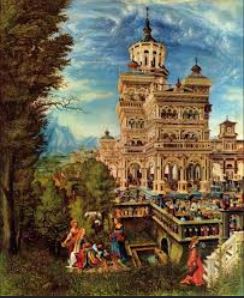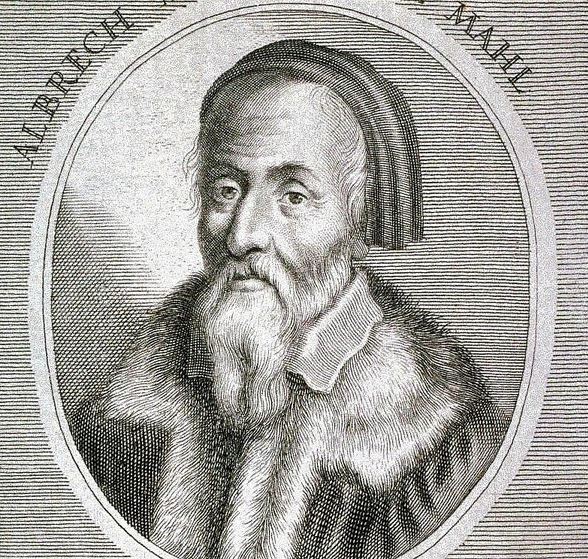About Albrecht Altdorfer
Albrecht Altdorfer (c. 1480–1538) was a prominent German painter, printmaker, and architect, best known for his contributions to the Danube School, an artistic movement that focused on landscape painting. He is often credited as one of the first artists to paint pure landscapes without human figures, emphasizing the beauty and majesty of nature.
Key Highlights of Albrecht Altdorfer:
- Pioneering Landscape Painting: Altdorfer was one of the earliest European artists to focus on landscapes as a subject in their own right, without the need for narrative or human figures. His works often feature detailed and dramatic natural scenery, with deep forests, mountainous terrain, and atmospheric light.
- Famous Works:
- “The Battle of Issus” (1529): One of his most celebrated pieces, this large and highly detailed painting depicts Alexander the Great’s victory over Darius III, combining historical narrative with sweeping, panoramic landscapes.
- “Saint George and the Dragon” (1510): A work that blends mythological elements with dense forests and dramatic skies, highlighting his mastery of landscape within narrative painting.
- “The Regensburg Danube Landscape”: A pure landscape painting that reflects his deep connection with nature.
- Architectural Works: Altdorfer was also involved in architecture, particularly in his hometown of Regensburg, where he contributed to various civic projects.
- Printmaking: As a printmaker, he produced woodcuts and engravings, often filled with complex compositions and fine detail. His prints were widely circulated and influential during his time.
- Style: His painting style is often marked by bright colors, dynamic compositions, and an almost mystical representation of nature. His landscapes often carry an emotional or spiritual depth, connecting nature to divine or historical themes.
Albrecht Altdorfer: A Deeper Dive
Artistic Innovation and Influence
- Landscape Painting: Altdorfer’s work represents a significant departure from the medieval tradition of integrating landscapes primarily as backdrops to religious or historical subjects. He infused his landscapes with intricate details and dramatic settings, giving nature a central role. His portrayal of landscapes as subjects of profound beauty and complexity influenced later artists, particularly those of the Baroque and Romantic periods.
- Symbolism and Mysticism: Many of Altdorfer’s landscapes carry a mystical or symbolic quality. His depictions of the natural world often reflect a deep spiritual or philosophical dimension. For example, the vast, detailed landscapes in his works can be interpreted as metaphors for the divine or the sublime.
- Innovative Techniques: Altdorfer employed innovative techniques to create depth and atmospheric effects in his paintings. His use of color and light, particularly in works like “The Battle of Issus,” demonstrates his mastery of capturing complex spatial relationships and atmospheric conditions.
Major Works and Their Significance
- “The Battle of Issus” (1529):
- This painting is renowned for its vivid portrayal of the historic battle between Alexander the Great and Darius III. The composition integrates a panoramic landscape with the chaotic scenes of battle, blending historical drama with the natural world. It exemplifies Altdorfer’s skill in merging narrative with landscape.
- “Saint George and the Dragon” (1510):
- In this work, Altdorfer combines a legendary narrative with an elaborate landscape. The painting showcases his ability to render dramatic natural settings that enhance the mythological and heroic elements of the story.
- “The Regensburg Danube Landscape”:
- This pure landscape painting highlights Altdorfer’s dedication to representing nature itself. The work is celebrated for its meticulous attention to natural details and its representation of the Danube River’s picturesque surroundings.

Architectural Contributions
- Regensburg Projects: Altdorfer was involved in several architectural projects in Regensburg, his hometown. His contributions included designing civic buildings and possibly influencing local architectural styles. Although less documented than his paintings, his architectural work reflects his broad artistic talent and community involvement.
Legacy and Impact
- Influence on Landscape Painting: Altdorfer’s focus on landscapes paved the way for future generations of artists who explored nature as a central theme. His work laid the groundwork for the landscape genre, influencing artists like Jacob van Ruisdael and the Romantic landscape painters.
- Cultural Relevance: His ability to capture the beauty and complexity of nature resonates with modern audiences and has solidified his place in art history. Altdorfer’s work remains a testament to the artistic exploration of natural beauty and its relationship to human experience.
- Preservation of Works: Many of Altdorfer’s works are housed in major museums and collections, including the Alte Pinakothek in Munich and the Kunsthistorisches Museum in Vienna. These institutions continue to preserve and exhibit his contributions to art history.
Albrecht Altdorfer’s innovative approach to landscape painting, coupled with his skill in integrating nature with narrative, marks him as a pioneering figure in the Northern Renaissance. His legacy endures through his detailed and expressive works, which continue to inspire and captivate audiences today.
Albrecht Altdorfer’s Influence and Recognition
- Northern Renaissance Context: Altdorfer’s work is a critical component of the Northern Renaissance, a period marked by detailed realism and an emphasis on the natural world. While artists like Albrecht Dürer were renowned for their printmaking and detailed portraits, Altdorfer distinguished himself through his unique approach to landscapes and his blend of history, mythology, and nature.
- Critics and Scholars: Art historians and critics have long recognized Altdorfer’s contributions to the development of landscape painting. His innovative methods and thematic focus have been subjects of extensive analysis. Scholars often highlight his ability to evoke emotional and symbolic resonance through his portrayals of natural settings.
- Modern Appreciation: In contemporary art studies, Altdorfer’s work is celebrated for its forward-thinking approach to landscape composition. Modern audiences appreciate his detailed and imaginative landscapes, which predate and influence later developments in landscape painting.
Altdorfer’s Artistic Techniques
- Detail and Precision: Altdorfer was known for his meticulous attention to detail. His landscapes often feature intricate foliage, textured surfaces, and dynamic atmospheric effects. This precision is not only visually captivating but also contributes to the thematic depth of his works.
- Use of Light and Color: Altdorfer’s manipulation of light and color adds to the dramatic quality of his paintings. In works like “The Battle of Issus,” the interplay between light and shadow enhances the sense of movement and depth, making the scenes more vivid and immersive.
- Innovative Compositions: His compositions frequently break away from traditional arrangements. By placing figures and events within expansive and detailed landscapes, he creates a sense of grandeur and complexity. This innovation contributes to the narrative and emotional impact of his works.
Albrecht Altdorfer’s Personal and Professional Life
- Early Life and Training: Altdorfer was born in Regensburg around 1480. He trained as a painter and engraver, becoming well-established in his hometown. His early exposure to the city’s vibrant artistic community likely influenced his development as an artist.
- Role in Regensburg: In addition to his artistic achievements, Altdorfer played an active role in Regensburg’s cultural and civic life. His involvement in local projects and architectural design reflects his commitment to the city and its artistic heritage.
- Later Years and Legacy: Altdorfer’s career continued to flourish until his death in 1538. His innovative approach and dedication to the landscape genre left a lasting impact on art. His work remains a testament to the rich artistic tradition of the Northern Renaissance and continues to be studied and admired by art enthusiasts and scholars.
Albrecht Altdorfer’s pioneering work in landscape painting, combined with his detailed and imaginative approach to art, marks him as a key figure in the Northern Renaissance. His ability to blend nature with narrative, his innovative techniques, and his active involvement in his community contribute to his enduring legacy. Through his masterpieces, Altdorfer has left an indelible mark on the art world, influencing generations of artists and continuing to captivate audiences with his visionary landscapes.
